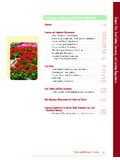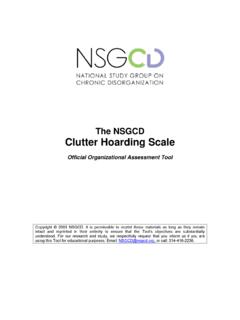Transcription of US FDA Regulation of Plastics used in food packaging
1 US FDA Regulation of Plastic used in food PackagingTom DunnSociety of Plastics EngineersWebinarFebruary 9, 2012 AgendaObjective: provide participants with enough knowledge of US FDA regulations for plastic food packaging to make their own compliance clearance clearance determinations2/8/20122 Flexpacknology llc 2012 You also need to know US FDA system: not Global Good Manufacturing Practice: added obligation Ultimate Enforcer: ConsumerWhile this is a best effort to describe regulatory requirements for plastic food packaging , public concern about food safety raise expectations above minimal Flexpacknology llc 2012I. BackgroundUS law controlling food packaging has a minimal statutoryfoundation but a comprehensive regulatorystructure Law-Federal food Drug and Cosmetic Act (1938) as Amended (1958-2011) 21 301 et seq.
2 regulations -21 CFR 170-199 Customary Special2/8/20124 Flexpacknology llc 2012I. BackgroundUS law controlling food packaging has a minimal statutoryfoundation but a comprehensive regulatorystructure Law-Federal food Drug and Cosmetic Act (1938) as Amended (1958-2011) 21 301 et seq. regulations -21 CFR 170-199 Customary SpecialThe US regulates food packaging material only if there is a reasonable expectation that, when used as intended, a part of it would become a component of the food [an additive + (with exceptions) .2/8/20125 Flexpacknology llc 2012 Compliance FundamentalThe law prohibits the introduction or delivery for introduction into interstate commerce of any food , drug, device, or cosmetic that is adulteratedor misbranded food additives must have premarket clearance or food used with it is unsafe and adulterated Customarypremarket clearance Specialpremarket clearance2/8/20126 Flexpacknology llc 2012 food packaging Compliance: FFD&CAAdditive ?]
3 Can packaging component(s) enter the food ?Cleared? YES: Is/are component(s) cleared by US FDA?Compliant ! YES: packaging material complies2/8/20127 Flexpacknology llc 2012 food packaging Compliance: no regs!Additive ? Can packaging component(s) enter the food ?USE! No: No FDA clearance required!2/8/20128 Flexpacknology llc 2012 food packaging : Non-complianceAdditive ? Can packaging component(s) enter the food ?Approved ? YES: Is/are component(s) cleared by US FDA?STOP No: packaging material fails to comply2/8/20129 Flexpacknology llc 2012II. Customary Clearance21 CFR Part:175 -Adhesives & Coatings176 -Paper & Paperboard177 -Polymers178 -Adjuvants, Production Aids, SanitizersIII.
4 SpecialClearance Generally Recognized as Safe Prior sanctioned Threshold of Regulation food Contact NotificationUSFDA Premarket Clearance2/8/201210 Flexpacknology llc 2012 regulations list the customary clearances and detail the procedures for determining special clearances for food additives in general. Over the years the FDA has given informal written opinions to inquiries as to the safety of articles intended for use as components of, or in contact with, food . Those written by the FDA after the food Additives Amendments of 1958 remain in forceTitle 21 CFR Chapters 170-1992/8/201211 Flexpacknology llc 2012 Separated by Common Language 12/8/201212 Flexpacknology llc 2012 Separated by Common Language 22/8/201213 Flexpacknology llc 2012 Separated by Common Language 32/8/201214 Flexpacknology llc 2012 Separated by Common Language 42/8/201215 Flexpacknology llc 2012 More Language BarriersPETOPPAlPP MATERIALS bottlebagcanjar ARTICLES !
5 21 CFR 2/8/201216 Flexpacknology llc 2012 Title 21 CFR Chapters 170-199 packaging material compliesCustomary ClearanceSpecial ClearanceAd Hoc ClearancePackaging component transfers to food ?Article UserMaterial SupplierArticle SupplierSupply Chain Interdependence is critical 2/8/201217 Flexpacknology llc 2012 The Regulation holds that physicalblends ( mixtures ) of substances are cleared if the individual substances have clearance. Chemicalreaction by-products of sterilization or in-package food processing may or may not change the status of otherwise cleared substances Chemicalreaction products of cleared substances are not assumed to have clearanceThe sum of the Parts2/8/201218 Flexpacknology llc 2012 The customary clearance listings in 21 CFR 175-178 come with three simple underlying compositionof cleared materials must match that approved by FDA for the qualityof cleared materials must meet FDA specifications for the cleared material must be suitablefor its intended use conditions and food types as defined by US CustomaryPremarket Clearance2/8/201219 Flexpacknology llc 2012
6 Customary ClearanceArticle SupplierMaterial SupplierArticle UserSupply Chain communication is critical 2/8/201220 Flexpacknology llc 2012 Compositional CompliancePartSectionMaterialComposition ( ) sensitive adhesiveButylated reaction product of p-cresol and dicyclopentadiene produced by reacting p-cresol and dicyclopentadiene in an approximate mole ratio of , respectively, followed by alkylation with isobutylene so that the butyl content of the final product is not less than 18 %, for use at levels not to exceed % by weight of the adhesive phthalate2/8/201221 Flexpacknology llc 2012 Specification CompliancePartMaterialComposition ( )Limitation175 Pressure sensitive adhesiveButylated reaction product of p-cresol and dicyclopentadiene produced by reacting p-cresol and dicyclopentadiene in an approximate mole ratio of , respectively, followed by alkylation with isobutylene so that the butyl content of the final product is not less than 18 %, for use at levels not to exceed % by weight of the adhesive butyl content of the final product is not less than 18 percent.
7 For use at levels not to exceed percent by weight of the adhesive formulation177 PolycarbonateMonoclorobenzeneNot to exceed 500 parts per million as residual solvent in finished phthalatenot exceeding 43 pct by weight of permitted vinyl chloride homo-and/or copolymers used in contact with food only of the types identified in Sec. (c) of this chapter, table 1, under Categories I, II, IV-B, and VIII, at temperatures not exceeding room temperature. The average thickness of such polymers in the form in which they contact food shall not exceed Flexpacknology llc 2012 Specification CompliancePartMaterialComposition ( )Limitation175 Pressure sensitive adhesiveButylated reaction product of p-cresol and dicyclopentadiene produced by reacting p-cresol and dicyclopentadiene in an approximate mole ratio of , respectively, followed by alkylation with isobutylene so that the butyl content of the final product is not less than 18 %, for use at levels not to exceed % by weight of the adhesive butyl content of the final product is not less than 18 percent.
8 For use at levels not to exceed percent by weight of the adhesive formulation177 PolycarbonateMonoclorobenzeneNot to exceed 500 parts per million as residual solvent in finished phthalatenot exceeding 43 pct by weight of permitted vinyl chloride homo-and/or copolymers used in contact with food only of the types identified in Sec. (c) of this chapter, table 1, under Categories I, II, IV-B, and VIII, at temperatures not exceeding room temperature. The average thickness of such polymers in the form in which they contact food shall not exceed to adhesive mixtureRelative to resinRelative to other section2/8/201223 Flexpacknology llc 2012 Suitable: food Types21 CFR 176(c): Table 1--Types of Raw and Processed Foods , aqueous products; may contain salt or sugar or both (pH above ).
9 , aqueous products; may contain salt or sugar or both, and including oil-in-water emulsions of low-or high-fat , acid or nonacid products containing free oil or fat; may contain salt, and including water-in-oil emulsions of low-or high-fat products and emulsions, high-or emulsions, high-or fats and up to 8 percent of more than 8 percent alcohol. products other than those included under Types VIII or IX of this bakery products with surface containing free fat or bakery products with surface containing no free fat or solids with the surface containing no free fat or oil (no end test required). solids with the surface containing free fat or Flexpacknology llc 2012 Suitable: Use Conditions21 CFR 176(c): Table 2 Conditions of Use temperature heat-sterilized ( , over 212 F).
10 Water filled or pasteurized above 150 filled or pasteurized below 150 temperature filled and stored (no thermal treatment in the container) storage (no thermal treatment in the container). storage (no thermal treatment in the container).Frozen or refrigerated storage: foods intended to be reheated in container at time of or oil-in-water emulsion of high-or low , high-or low free oil or fat. 2/8/201225 Flexpacknology llc 2012 New Use ConditionsGuidance for Industry: Preparation of Premarket Submissions for food Contact Substances: Chemistry Recommendations(applicable only to certain special clearance determinations) (ionizing radiation). at temperatures exceeding 121 C (250 F).


